Features: Flower Shows |  |
The RHS Chelsea Flower Show 2004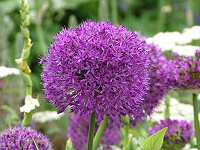 Allium from the Daihatsu Green Garden. (View bigger image.)
2004, the bicentenary year of the Royal Horticultural Society (RHS), sees the 82nd annual Chelsea Flower Show which was first held on the site of the Royal Hospital, Chelsea in 1913. Amongst the horticultural establishment, Chelsea is seen as the main event of a busy calendar. Changing gardening styles,
movements and trends have been heralded and reflected at Chelsea since its inception and Allium from the Daihatsu Green Garden. (View bigger image.)
2004, the bicentenary year of the Royal Horticultural Society (RHS), sees the 82nd annual Chelsea Flower Show which was first held on the site of the Royal Hospital, Chelsea in 1913. Amongst the horticultural establishment, Chelsea is seen as the main event of a busy calendar. Changing gardening styles,
movements and trends have been heralded and reflected at Chelsea since its inception and  I was interested to see how growing concern for the wider environment and a rising interest in garden biodiversity would be reflected in this, the world's premier horticultural show I was interested to see how growing concern for the wider environment and a rising interest in garden biodiversity would be reflected in this, the world's premier horticultural show I was interested to see how growing concern for the wider environment and a rising interest in garden biodiversity would be reflected in this, the world's premier horticultural show. I was interested to see how growing concern for the wider environment and a rising interest in garden biodiversity would be reflected in this, the world's premier horticultural show.
The RHS were kind enough to provide SpaceForNature with a press pass and what follows is an account of what I found to be of interest to the wildlife gardener. I did not visit all the gardens; there simply was not enough time. I selected which exhibits I most wanted to see before hand by trawling the exhibitor list and I managed to get round all of these as well as a number of others. However the sheer size of the show means that it is likely that I missed a few exhibits of interest; and for that I apologize.
The Daihatsu Green Garden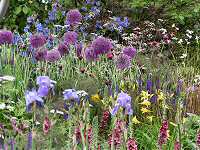 The sophisticated planting of the Daihatsu Green Garden. (View bigger image.)
This Show Garden was the garden which first drew my attention to Chelsea 2004 when I read about the plans for it back in March (see Wildlife garden competition result). Schoolchildren from Burntwood School For Girls, Tooting won a competition to design a domestic garden which embraced the principles of biodiversity: seeing the garden realised at Chelsea was their prize! The sophisticated planting of the Daihatsu Green Garden. (View bigger image.)
This Show Garden was the garden which first drew my attention to Chelsea 2004 when I read about the plans for it back in March (see Wildlife garden competition result). Schoolchildren from Burntwood School For Girls, Tooting won a competition to design a domestic garden which embraced the principles of biodiversity: seeing the garden realised at Chelsea was their prize!
 Although designed by these budding young amateurs, the realised garden was anything but amateurish Although designed by these budding young amateurs, the realised garden was anything but amateurish Although designed by these budding young amateurs, the realised garden was anything but amateurish; in fact it was very highly polished. I had expected a lot of native planting but although the style was naturalistic, a large number of sculptural non-native plants were used to good effect. Although designed by these budding young amateurs, the realised garden was anything but amateurish; in fact it was very highly polished. I had expected a lot of native planting but although the style was naturalistic, a large number of sculptural non-native plants were used to good effect.
 Personally, I would have preferred to see native plants featured more prominently Personally, I would have preferred to see native plants featured more prominently Personally, I would have preferred to see native plants featured more prominently, Personally, I would have preferred to see native plants featured more prominently,
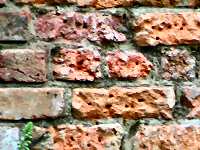 Pitted wall for nesting bees. (View bigger image.)
partly because I would like an interest in native plants to be fostered amongst youngsters and also because, on balance, I think that a little more thoughtful use of them would have made it more attractive to invertebrates. However the garden was extremely elegant and did included a number of design features specifically aimed at bringing wildlife into the garden: a pitted wall for mason and mining bees; an upturned tree-stump to act as a bird table; and a log pile 'hotel' for invertebrates to name a few. Pitted wall for nesting bees. (View bigger image.)
partly because I would like an interest in native plants to be fostered amongst youngsters and also because, on balance, I think that a little more thoughtful use of them would have made it more attractive to invertebrates. However the garden was extremely elegant and did included a number of design features specifically aimed at bringing wildlife into the garden: a pitted wall for mason and mining bees; an upturned tree-stump to act as a bird table; and a log pile 'hotel' for invertebrates to name a few.
I greatly admired this garden, both for the design and for the finished product; but I couldn't avoid the impression that the professionalism of the execution and the selection of plants somewhat masked the spirit of its youthful designers. The garden was awarded a Silver medal by the RHS.
The Gardman Wild Bird Garden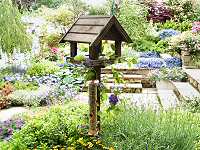 The Gardman Wild Bird Garden. (View bigger image.)
This garden was designed by David Domoney with input from the British Trust for Ornithology and was sponsored by Gardman Ltd (suppliers of bird feeders). The garden was dominated by a large patio area on three levels with plenty of shrubs and perennial borders planted largely with species that benefit birds, either directly (e.g. by supplying fruit) or indirectly (by attracting insects on which birds can feed). The Gardman Wild Bird Garden. (View bigger image.)
This garden was designed by David Domoney with input from the British Trust for Ornithology and was sponsored by Gardman Ltd (suppliers of bird feeders). The garden was dominated by a large patio area on three levels with plenty of shrubs and perennial borders planted largely with species that benefit birds, either directly (e.g. by supplying fruit) or indirectly (by attracting insects on which birds can feed).  the design did meet its stated intention of showing that a garden which is good for birds does not have to be 'wild' the design did meet its stated intention of showing that a garden which is good for birds does not have to be 'wild' My initial reaction was one of disappointment: for me the garden lacked immediate impact - the 'wow factor' if you like. But although a little too formal for my personal tastes the design did meet its stated intention of showing that a garden which is good for birds does not have to be 'wild' and many people who prefer a formal design will have been encouraged by this. The garden was awarded a bronze medal by the RHS. My initial reaction was one of disappointment: for me the garden lacked immediate impact - the 'wow factor' if you like. But although a little too formal for my personal tastes the design did meet its stated intention of showing that a garden which is good for birds does not have to be 'wild' and many people who prefer a formal design will have been encouraged by this. The garden was awarded a bronze medal by the RHS.
The Garden of Hope
Jeff Goundrill designed this garden for HMP Leyhill. This was very much a 'wild garden' but also one with a prominent theme. The garden aimed to represent a war damaged cottage and garden which is recovering through nature as an allegory for 'the feelings of the average person and their hopes for a better future during times of constant aggression and conflict'.
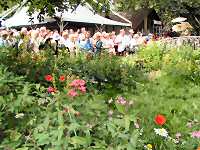 Crowds at the Garden of Hope. (View bigger image.) Crowds at the Garden of Hope. (View bigger image.) the theme of this garden was something of a distraction from the actual reality of it the theme of this garden was something of a distraction from the actual reality of it I know that themes are part and parcel of the show garden phenomenon, but sometimes, like here, I think that they are overdone. For me, the theme of this garden was something of a distraction from the actual reality of it. The ruined cottage, whilst important in the theme, simply did not add anything to the actual garden as far as I was concerned; and a patch of grass which was left overgrown, no doubt again in pursuance of the theme, could have been mown to contrast beautifully with the naturalistic planting and enhance the garden enormously. I know that themes are part and parcel of the show garden phenomenon, but sometimes, like here, I think that they are overdone. For me, the theme of this garden was something of a distraction from the actual reality of it. The ruined cottage, whilst important in the theme, simply did not add anything to the actual garden as far as I was concerned; and a patch of grass which was left overgrown, no doubt again in pursuance of the theme, could have been mown to contrast beautifully with the naturalistic planting and enhance the garden enormously.
However, putting all that aside, for me  this garden was a delight thanks to the planting this garden was a delight thanks to the planting this garden was a delight thanks to the planting. An impressive list of native plants was employed more extensively than in any other garden at the show. I am sure that it was this wonderful naturalistic planting, rather than the laboured theme, which drew such big crowds to the garden. The RHS awarded this garden a silver medal. this garden was a delight thanks to the planting. An impressive list of native plants was employed more extensively than in any other garden at the show. I am sure that it was this wonderful naturalistic planting, rather than the laboured theme, which drew such big crowds to the garden. The RHS awarded this garden a silver medal.
A Dream Come True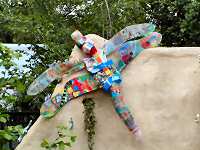 Dragonfly artwork detail from A Dream Come True. The dragonfly is set on a rendered 'hemp' wall. (View bigger image.)
This garden was designed by Celia Spouncer as the result of a workshop she undertook with year six children from Cedar Integrated Primary School (ages 9 to 10). Dragonfly artwork detail from A Dream Come True. The dragonfly is set on a rendered 'hemp' wall. (View bigger image.)
This garden was designed by Celia Spouncer as the result of a workshop she undertook with year six children from Cedar Integrated Primary School (ages 9 to 10).  I liked this garden: it was fun - an element often missing from other show gardens I liked this garden: it was fun - an element often missing from other show gardens I liked this garden: it was fun - an element often missing from other show gardens (which often substitute cleverness instead). The theme was one of environmentally friendliness, expressed through the materials used to build the garden, many of which were recycled, as well as by the native planting and wildlife-friendly features of the design. Art was an important feature of the design and was bravely and confidently executed, enhancing the ambience of the finished garden. I liked this garden: it was fun - an element often missing from other show gardens (which often substitute cleverness instead). The theme was one of environmentally friendliness, expressed through the materials used to build the garden, many of which were recycled, as well as by the native planting and wildlife-friendly features of the design. Art was an important feature of the design and was bravely and confidently executed, enhancing the ambience of the finished garden.
To my mind this garden, though neither as polished nor as beautiful as The Daihatsu Green Garden, did succeed where that garden failed in directly expressing something of the spirit of its designers. The RHS awarded this garden a silver gilt medal.
Salix: An Environmentally Responsible Garden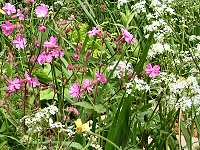 Native planting in Salix: An Environmentally Responsible Garden. (View bigger image.) Native planting in Salix: An Environmentally Responsible Garden. (View bigger image.) This was one of my favourite gardens of the show This was one of my favourite gardens of the show This was one of my favourite gardens of the show. It was designed by Annie Evans, Sam Parsons and Lee Dalby and, as the name makes clear, it was conceived and executed very much with the wider environment in mind. Despite being a very modern and elegant garden, virtually all the materials employed were recycled in some way; from the RSJs, which made a rill, to the broken terracotta used as a mulch This was one of my favourite gardens of the show. It was designed by Annie Evans, Sam Parsons and Lee Dalby and, as the name makes clear, it was conceived and executed very much with the wider environment in mind. Despite being a very modern and elegant garden, virtually all the materials employed were recycled in some way; from the RSJs, which made a rill, to the broken terracotta used as a mulch
The garden consisted of a central seating area surrounded by a rill constructed from reclaimed RSJs. A path which ran trough the garden was covered by a woven willow 'carpet': a very unusual and effective element. Willow was also used to make the garden chairs and featured in the garden in several other ways besides.  All this beautiful design and construction was complemented extremely well by imaginative and creative use of native species All this beautiful design and construction was complemented extremely well by imaginative and creative use of native species All this beautiful design and construction was complemented extremely well by imaginative and creative use of native species (or varieties of native species). I think that the planting here was one of the best examples of native planting at the show. The RHS awarded the garden a silver medal. All this beautiful design and construction was complemented extremely well by imaginative and creative use of native species (or varieties of native species). I think that the planting here was one of the best examples of native planting at the show. The RHS awarded the garden a silver medal.
The Wildlife Trusts Gateway Garden The Wildlife Trusts Gateway Garden. (View bigger image.)
Stephen Hall designed this garden for the Wildlife Trusts. Like the Gardman Wild Bird Garden, this one aimed to show how a garden can be made attractive and useful to wildlife without necessarily being 'wild'. The design was 'semi-formal' including a paved area and a semi-formal pool. The The Wildlife Trusts Gateway Garden. (View bigger image.)
Stephen Hall designed this garden for the Wildlife Trusts. Like the Gardman Wild Bird Garden, this one aimed to show how a garden can be made attractive and useful to wildlife without necessarily being 'wild'. The design was 'semi-formal' including a paved area and a semi-formal pool. The  attention to detail was excellent with a large number of wildlife gardening techniques and features used attention to detail was excellent with a large number of wildlife gardening techniques and features used attention to detail was excellent with a large number of wildlife gardening techniques and features used without being obtrusive in any way. attention to detail was excellent with a large number of wildlife gardening techniques and features used without being obtrusive in any way.
The pool was particularly interesting because of its semi-formal design - not at all the naturalistic 'wildlife pond' more normally promoted for wildlife gardens.
 A rose in the The Wildlife Trusts Gateway Garden. (View bigger image.)
Many people who prefer a formal element in the design of their water features will have taken encouragement from the inclusion of this kind of pool in the Wildlife Trust's garden. It shows that A rose in the The Wildlife Trusts Gateway Garden. (View bigger image.)
Many people who prefer a formal element in the design of their water features will have taken encouragement from the inclusion of this kind of pool in the Wildlife Trust's garden. It shows that  formal water features can also be made useful to wildlife with a few design tweaks formal water features can also be made useful to wildlife with a few design tweaks formal water features can also be made useful to wildlife with a few design tweaks. formal water features can also be made useful to wildlife with a few design tweaks.
The planting in the garden was interesting. I had expected to see more native species, but it had very much the cottage garden feel. Again, this will have encouraged some people who are still, for whatever reason, nervous about using many native species in the garden. The RHS awarded this garden a silver medal.
The Woodcutter's Garden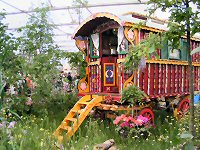 The Woodcutters Garden: not a show garden but an exhibit within the Great Pavillion. (View bigger image.)This was great fun. Actually The Woodcutters Garden: not a show garden but an exhibit within the Great Pavillion. (View bigger image.)This was great fun. Actually  an exhibit inside the Great Pavillion, this garden was, nonetheless, the equal of many of the show gardens outside an exhibit inside the Great Pavillion, this garden was, nonetheless, the equal of many of the show gardens outside an exhibit inside the Great Pavillion, this garden was, nonetheless, the equal of many of the show gardens outside. Created by the Leisure Services Department of Southend-on-Sea Borough Council, the garden was themed on a Romany caravan set in native woodland and meadowland. an exhibit inside the Great Pavillion, this garden was, nonetheless, the equal of many of the show gardens outside. Created by the Leisure Services Department of Southend-on-Sea Borough Council, the garden was themed on a Romany caravan set in native woodland and meadowland.
For me the meadow planting was the really attractive feature of this garden, skilfully mixing native and non-native species to excellent effect. The RHS liked this exhibit too, awarding it a gold medal.
Lifelong Learning in the Garden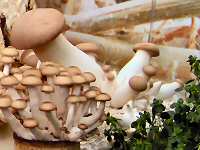 Detail from the stand of the British Mycological Society. (View bigger image.)
There was an area in the Great Pavillion given over to stands with an education angle: this was termed the 'The Lifelong Learning in the Garden Educational and Scientific Displays'. I very much enjoyed this area, visiting stands of The Oxford Bee Co Ltd, Cornwall Knotweed Forum, HDRA - The Organic Organisation, British Mycological Society and Writtle College.
These stands all had something to say to people interested in garden wildlife. Detail from the stand of the British Mycological Society. (View bigger image.)
There was an area in the Great Pavillion given over to stands with an education angle: this was termed the 'The Lifelong Learning in the Garden Educational and Scientific Displays'. I very much enjoyed this area, visiting stands of The Oxford Bee Co Ltd, Cornwall Knotweed Forum, HDRA - The Organic Organisation, British Mycological Society and Writtle College.
These stands all had something to say to people interested in garden wildlife.  The Writtle College stand, Tell Tale Plants, did a good job of conveying something of the fascinating relationship that native plants have to our culture The Writtle College stand, Tell Tale Plants, did a good job of conveying something of the fascinating relationship that native plants have to our culture The Writtle College stand, Tell Tale Plants, did a good job of conveying something of the fascinating relationship that native plants have to our culture. It was just this kind of angle that I felt was left unexplored by the Daihatsu Green Garden. The Writtle College stand, Tell Tale Plants, did a good job of conveying something of the fascinating relationship that native plants have to our culture. It was just this kind of angle that I felt was left unexplored by the Daihatsu Green Garden.
I particularly enjoyed the stand of the The Oxford Bee Company because I have read about their work (The Red Mason Bee and Bumblebees) and they were showing live red mason bees (Osmia rufra) in an apiary. Whilst I was looking at the bees, one of the people manning the stand approached me to tell me more about them and answer my questions.  I came away full of enthusiasm for red mason bees and determined to try out one of the red mason bee nesting kits in my garden I came away full of enthusiasm for red mason bees and determined to try out one of the red mason bee nesting kits in my garden I came away full of enthusiasm for red mason bees and determined to try out one of the red mason bee nesting kits in my garden. I came away full of enthusiasm for red mason bees and determined to try out one of the red mason bee nesting kits in my garden.
The SpaceForNature Natural Choice Award
I thought that it would be a nice idea to try and evaluate the gardens I saw from the point of view of their attractiveness to wildlife. As I visited each garden I was looked to see how many invertebrates (mostly hoverflies and bees) were attracted to each one.
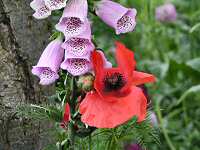 Planting detail from The Garden of Hope. (View bigger image.)
Given the constraints of time and access, there was no way to objectively evaluate each garden in this respect and therefore this could only be a subjective bit of fun. Nevertheless, taking into account the number and variety of invertebrates I saw during my brief visit to each garden and my overall impression of the wildlife value of each, Planting detail from The Garden of Hope. (View bigger image.)
Given the constraints of time and access, there was no way to objectively evaluate each garden in this respect and therefore this could only be a subjective bit of fun. Nevertheless, taking into account the number and variety of invertebrates I saw during my brief visit to each garden and my overall impression of the wildlife value of each,  SpaceForNature Natural Choice Awards go to the The Garden of Hope and Salix: An Environmentally Responsible Garden SpaceForNature Natural Choice Awards go to the The Garden of Hope and Salix: An Environmentally Responsible Garden SpaceForNature Natural Choice Awards go to the The Garden of Hope and Salix: An Environmentally Responsible Garden. SpaceForNature Natural Choice Awards go to the The Garden of Hope and Salix: An Environmentally Responsible Garden.
Both gardens scored well on the invertebrate front (as did a number of others). The sheer volume and variety of native planting and the imaginative way in which it was used set The Garden of Hope apart from the others. The Salix garden was beautifully designed and, as an example of a garden which was not in the 'naturalistic' idiom, was a wonderful example of how a garden that is environmentally sensitive and attractive to wildlife can also be a sophisticated and modern space for people too.
Lasting impressions
The Chelsea Flower Show is an assault on the senses: a visit leaves your head swimming with various impressions and you can hardly fail to come away without some ideas for your own garden. Quite apart from the things of particular relevance to wildlife gardening, the show was packed with amazing gardens, structures and plants that can be enjoyed on many different levels.
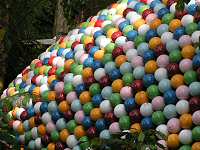 Detail of the 'pod' from A Colourful Suburban Eden. (View bigger image.)
Apart from the gardens I have already described, Detail of the 'pod' from A Colourful Suburban Eden. (View bigger image.)
Apart from the gardens I have already described,  Diarmuid Gavin's Show Garden, A Colourful Suburban Eden, was for me a 'must-see'; and I loved it Diarmuid Gavin's Show Garden, A Colourful Suburban Eden, was for me a 'must-see'; and I loved it Diarmuid Gavin's Show Garden, A Colourful Suburban Eden, was for me a 'must-see'; and I loved it. As a designer renowned for the way-out structures he incorporates into his gardens and his tendency to spurn naturalistic themes (because "nature does it better"), he is perhaps as far removed from a 'wildlife gardener' as most people would imagine; yet I absolutely share his viewpoint that gardens should be fun and not constrained by any sort of dogma. To me the 'pod', covered in hundreds of multi-coloured ceramic balls and cradled in the gentle green of his planting (which actually was quite naturalistic), was a beautiful thing and somehow absolutely 'of the garden'. To me there is no reason why wildlife gardening techniques (which like organic gardening techniques are largely Diarmuid Gavin's Show Garden, A Colourful Suburban Eden, was for me a 'must-see'; and I loved it. As a designer renowned for the way-out structures he incorporates into his gardens and his tendency to spurn naturalistic themes (because "nature does it better"), he is perhaps as far removed from a 'wildlife gardener' as most people would imagine; yet I absolutely share his viewpoint that gardens should be fun and not constrained by any sort of dogma. To me the 'pod', covered in hundreds of multi-coloured ceramic balls and cradled in the gentle green of his planting (which actually was quite naturalistic), was a beautiful thing and somehow absolutely 'of the garden'. To me there is no reason why wildlife gardening techniques (which like organic gardening techniques are largely
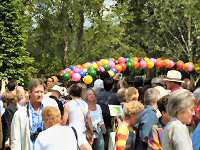 Crowds with lollipops from A Colourful Suburban Eden. (View bigger image.)
'invisible') could not be applied in a garden like this one: Crowds with lollipops from A Colourful Suburban Eden. (View bigger image.)
'invisible') could not be applied in a garden like this one:  I can quite imagine lounging in one of the pod's hanging seats and watching the hoverflies, butterflies and birds moving around and through it I can quite imagine lounging in one of the pod's hanging seats and watching the hoverflies, butterflies and birds moving around and through it I can quite imagine lounging in one of the pod's hanging seats and watching the hoverflies, butterflies and birds moving around and through it. I can quite imagine lounging in one of the pod's hanging seats and watching the hoverflies, butterflies and birds moving around and through it.
One of the less attractive features of the show is the large number of other people with whom you have to share it! There were some show gardens that I didn't get to see because I was not prepared to queue for 50 minutes in order to do so. However, I did manage to see everything that I had planned to before going and I'm sure that the determined spectator would be able to see all the gardens over the course of a day.
By and large Chelsea 2004 demonstrated that RHS is continuing to encourage people to think more about biodiversity in the garden and the relationship between gardens and the wider environment. However it is still, unmistakably, seen as a bit of a side issue. I believe that in time we can expect to see that change: as environmental issues continue to move upwards on the public and political agendas, concern for, and interest in, wildlife and the environment will move into the centre ground of gardening.
| First published May 2004. | |
Copyright Richard Burkmar 2004. Permission is hereby granted for anyone to use this article for non-commercial purposes which are of benefit to the natural environment as long the original author is credited. School pupils, students, teachers and educators are invited to use the article freely. Use for commercial purposes is prohibited unless permission is obtained from the copyright holder. |
Back to home page
Do you live in Merseyside? Interested in its wildlife? |